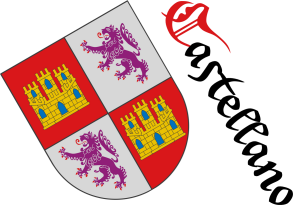
![Ver [Rabbow, A.; 1999] en referencias bibliográficas. Libro abierto, hojas de plata, filo de oro, guardas de gules, tapas de sable.](../css/Libro.Bibliografia.png)
Rabbow, A.; 1999
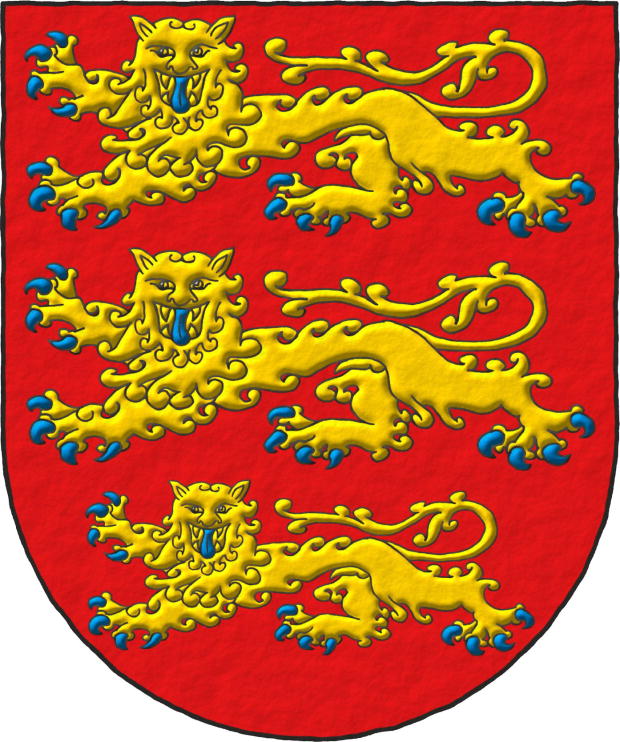
Arnold Rabbow, «The Origin of the Royal Arms of England - a European Connection», Coat of Arms, COA, An Heraldic Quarterly Magazine, número 186, The Heraldry Society, Baldock, Hertfordshire, verano de 1999.
This bibliographical reference is illustrated wit the coat of arms of the Kingdom of England interpreted by me with the with a semi-circle shape.
Bibliographical reference of century XX.
The author is Rabbow, Arnold.
The following article cites this bibliographic reference:
External link:
Internal resources: RabbowA1999.OriginRoyalArmsEnglandEuropeanConnection.docx.


Leonor de Aquitania
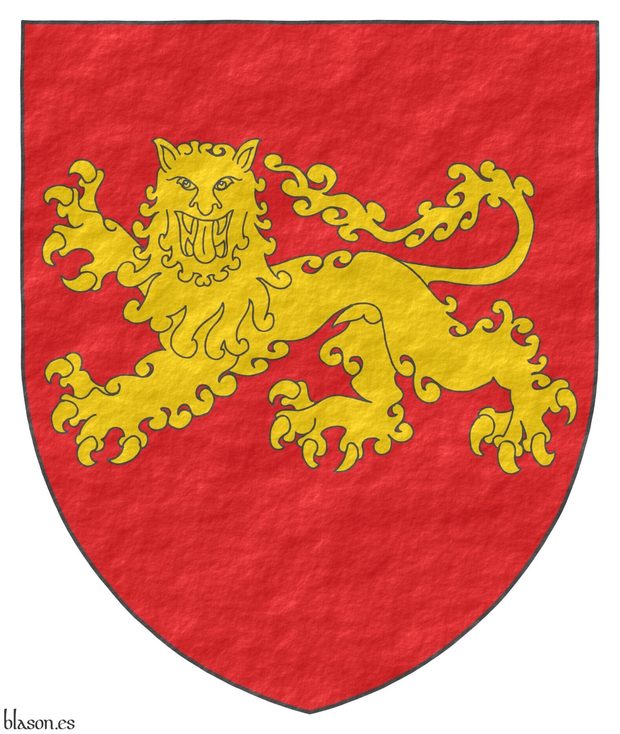
Duchess of Aquitaine, Queen Consort of France (1137-1152), and Queen Consort of England (1154-1189).
Gules, a lion passant, guardant Or.
Escudo de gules, un leopardo de oro.
Existing arms interpreted by me as follows: the escutcheon's shape is pointed; the field has been enamelled in flat Gules; the leopard in Or is outlined in Sable; and the whole composition has a rough texture finish.
I have blazoned it as a leopard, which is the term used for a lion when passant, [Avilés, J.; 1725a; pages 290 and 295] and [Avilés, J.; 1780a; pages 325 and 330] «a lion, whose natural position is rampant;... unlike the leopard, which is... always passant» and «leopards have... their heads facing forward, showing both eyes,... lions are... in profile, revealing only one eye... Their posture is never rampant, like the lion’s, but always passant;... if leopards are ever depicted rampant, they are blazoned as ‘leopard-lions’,... and likewise, lions that are passant are blazoned as ‘lion-leopards’.».
For this interpretation of Eleanor’s coat of arms, I have followed [Edward IV of England; 1461; shield 18], where a leopard Or appears, but neither armed nor langued in Azure, representing the Duchy of Aquitaine.
Blazon keywords: Without divisions, Gules, One, Leopard and Or.
Style keywords: Pointed, Plain tincture, Outlined in sable and Rough.
Classification: Interpreted, Personal, Coat of arms, Duchy of Aquitaine, Kingdom of France and Kingdom of England.
Bearer: Leonor de Aquitania.


Leonor de Aquitania y Enrique de Inglaterra
[ Gules, a lion rampant Or, ] accolé with [ Gules, a lion passant, guardant Or ].
[ Escudo de gules, un león rampante de oro, ] acolado de un [ escudo de gules, un leopardo de oro].
Existing arms interpreted by me as follows: both coat of arms are rotated ±30o; their shapes are pointed; the field of each coat of arms has been enamelled in flat Gules; the lion and the leopard in Or are outlined in Sable; and the whole composition of both arms has a rough texture finish.
Examples of accolated coat of arms (written as «accolé» in the 18th century) can be seen in [Avilés, J.; 1780a; pages 24 and 25 and plate 1: figures 1 and 2].
Blazon keywords: Without divisions, Gules, One, Lion, Or, Rampant and Leopard.
Style keywords: Pointed, Plain tincture, Outlined in sable, Tilted shield and Metal beaten.
Classification: Interpreted, Personal, Accolé arms, Duchy of Aquitaine, Kingdom of France and Kingdom of England.
Bearer: Leonor de Aquitania.


Leonor de Aquitania, escudo redondeado
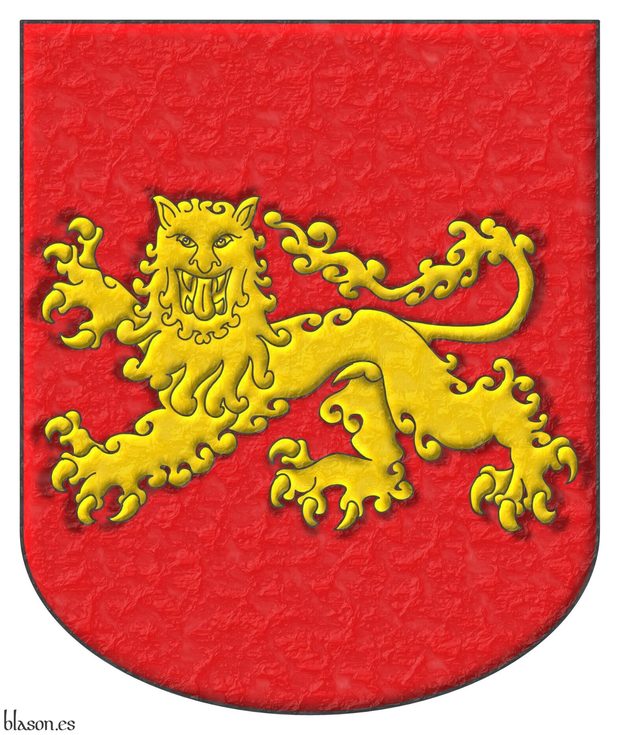
Gules, a lion passant, guardant Or.
Escudo de gules, un leopardo de oro.
Arms interpreted by me with: the shape of the coat of arms rounded; the field illuminated in Gules; the leopard illuminated in Or, outlined in Sable, and shaded; and the whole composition finished with a marble texture.
A description of the leopard in heraldry can be found in [Medél, R.; 1846; page 38].
Blazon keywords: Without divisions, Gules, One, Leopard and Or.
Style keywords: Rounded, Illuminated, Outlined in sable and Marmoreal.
Classification: Interpreted, Personal, Coat of arms, Duchy of Aquitaine, Kingdom of France and Kingdom of England.
Bearer: Leonor de Aquitania.


![Ver [Avilés, J.; 1725a] en referencias bibliográficas. Libro abierto, hojas de plata, filo de oro, guardas de gules, tapas de sable.](../css/Libro.Bibliografia.png)
Avilés, J.; 1725a
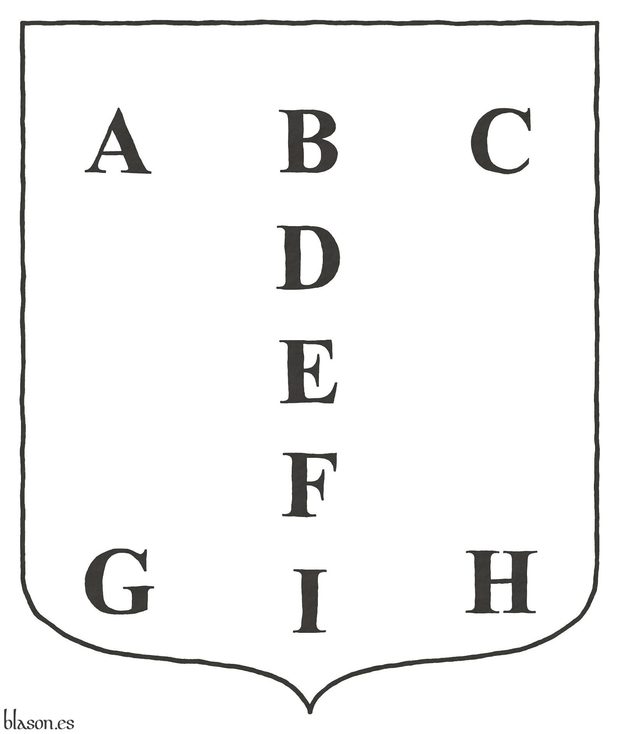
José de Avilés e Iturbide, Marquis of Aviles, member of the Supreme Council of War, «Ciencia heroyca, reducida a las leyes heráldicas del blasón: Ilustrada con exemplares de todas las piezas, figuras y ornamentos de que puede componerse un escudo de armas interior y exteriormente, Volume I», dedicated to Juan Bautista de Orendyn of His Majesty's Council, printed by Juan Piferrer of the Ángel's Square, 530 pages, Barcelona, 1725.
I also usually consult Volume I of the edition [Avilés, J.; 1780a].
Contents of Volume One
- Cover page.
- Dedication.
- Censor's review from 1724.
- Approval.
- To the reader.
- Epigram.
- Summary of privileges.
- Summary of the price.
- Plate index.
- Warnings.
- Errata sheet for each of the treatises.
- Additions.
- Table of the treatises.
- 378 pages for its 4 treatises: Treatise I with 3 chapters and a dictionary, Treatise II with 3 chapters, Treatise III with 3 chapters, and Treatise IV with 4 chapters.
- 34 plates with more than 650 coats of arms arranged at the end of each treatise, as follows: Plates 1 to 16 at the end of Treatise I, Plates 17 to 19 at the end of Treatise II, Plate 20 at the end of Treatise III, and Plates 21 to 34 at the end of Treatise IV.
- Index of terms, words, and figures specific to blazonry.
- Index of cities, titles, and families with coats of arms blazoned in this second volume.
Bordure compony
Bibliographical reference of century XVIII.
Classification: De bibliotheca, In black and white and Castilian language.
Author: Avilés e Iturbide, José.
Bibliographic reference mentioned in the following articles:
- Adrian V
- Baudry in France
- Bourgeois, lineage of Burgundy
- Criteria used by its title
- Dancetty, ratio, points and blazon
- Edmund Plantagenet
- Enrique Fernández Marqués, two supporters
- Ferdinand II of Leon
- Flanched, schemaat one-fifth
- Hector of Troy
- Hector of Troy, Sable
- Hufflepuff House with 2 badgers
- Innocent IV
- Leonor de Aquitania
- Navarre
- Nhf, Norsk Heraldisk Forening
- Oschoven of the Rhin
- Pile issuant from the base in the Dictionary of the Spanish Language
- Richard I of England
- The Heraldry Society of Scotland
- Triangulation 1, contre-embrassés, chapé, embrassé, and chaussé
- Triangulation 2, chaussé, contre-embrassé, embrassé, and chapé
- Triangulation 6, embrassé, chaussé, chapé, and contre-embrassé
- Triangulation 7, chaussé, contre-embrassé, embrassé, and chapé
External resources:
- Valencian Digital Library, records for the Volumes I and II.
- Valencian Digital Library, content of Volume I.
Internal resources: AvilesJ1725.Tomo.I.pdf.


![Ver [Edward IV of England; 1461] en referencias bibliográficas. Libro abierto, hojas de plata, filo de oro, guardas de gules, tapas de sable.](../css/Libro.Bibliografia.png)
Edward IV of England; 1461
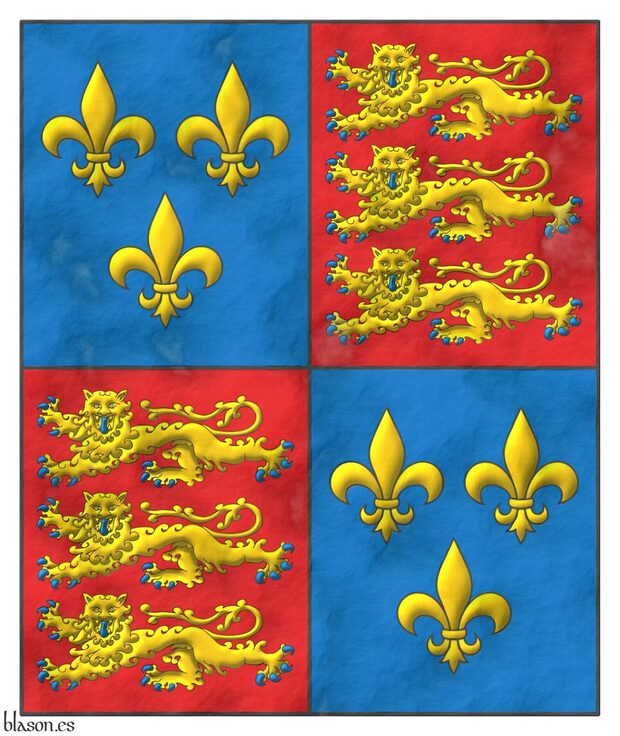
Edward IV King of England and Lord of Ireland, «The Armorial of Edward IV», «The Edward IV Roll», armorial in the form of a roll about 6 meters long, created to celebrate the coronation of Edward IV as the first King of England from the House of York and illustrated, probably, by different artists, 1461.
The image illustrating this reference corresponds to the banner, which is number 27 in the 2nd column, the final one of this armorial. This banner is held by a white deer, which was a personal badge of King Richard II of England, and also, two white deer were the supporters of his shield. The reason for the inclusion of this white deer might be to contribute to the legitimization of Edward IV as king.
It is notable that in row 25 of the 2nd column of this armorial there is a banner with the arms of the shield of Castilla y León, probably because Edward IV, like his predecessors, claimed their throne. In this version of the shield of Castilla y León:
- The two gold castles, in the 1st and 4th quarters of gules, have three towers with the central one taller like the Castilian, but the twin side towers seem to be connected by the wall as in the English castle, [Valero de Bernabé, L.; 2009a; page 2] and [Valero de Bernabé, L.; 2009b; page 33], the wall has a door that is enameled in azure as in the Castilian.
- The two lions, in the 2nd and 3rd quarters of silver, seem to be gold, therefore, of «metal on metal» and, furthermore, very different from the purple lion of Castilla y León, it could well be an error by the artist or a degradation of an original purple enamel to ochre, as explained in the pendón de Castilla y León.
This shield of Castilla y León also appears:
- On the banner in row 27 of the 1st column of this armorial. In this banner, they are combined with the arms of England represented in this article, in a new quartered, under an escutcheon with the imaginary arms of «Brutus of Troy», the also imaginary founder and king of Britain.
- On the caparison of the horse that Edward IV rides in the portrait at the beginning of his armorial. This caparison is a reproduction of the previous banner in row 27 of the 1st column that combined the arms of England with those of Castilla y León. The presence of these arms in this initial portrait of the armorial of Edward IV denotes the importance he gave to his aspirations to the crown of Castilla y León.
Bibliographical reference of century XV.
Author: Edward IV of England.
Bibliographic reference mentioned in the following articles:
- Banner of Castile and León
- Brutus of Britain
- Brutus of Britain, banner
- Charles V of France
- Edward IV of England
- Edward IV, armorial for His coronation
- Edward IV, quartered con Castile and León
- Heraldica Nova
- King Arthur, 3 crowns in pale
- King Arthur, banner with 3 crowns in pale
- King Arthur, banner with cross flory
- King Arthur, cross flory
- Leonor de Aquitania
- Pendón con inescutcheon de Edward IV
External resources:


Exercise of ARCO rights
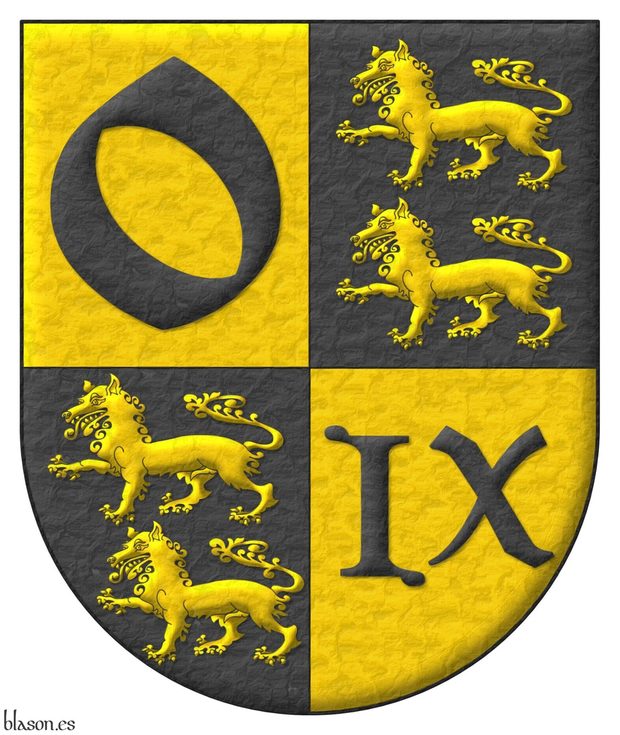
Exercise by mail
The interested parties with personal data in this data file have the right to access, rectify, cancel and oppose (so-called ARCO rights), which can be exercised by addressing the person responsible for the file:
- Antonio Salmeron Cabañas
- Paseo de la Castellana 135, 7th floor
- 28046 Madrid
- Spain
Email exercise
The user who wishes to exercise them more directly can send an email to the following address .


![Ver [Royal Spanish Academy; 2014] en referencias bibliográficas. Libro abierto, hojas de plata, filo de oro, guardas de gules, tapas de sable.](../css/Libro.Bibliografia.png)
Royal Spanish Academy; 2014
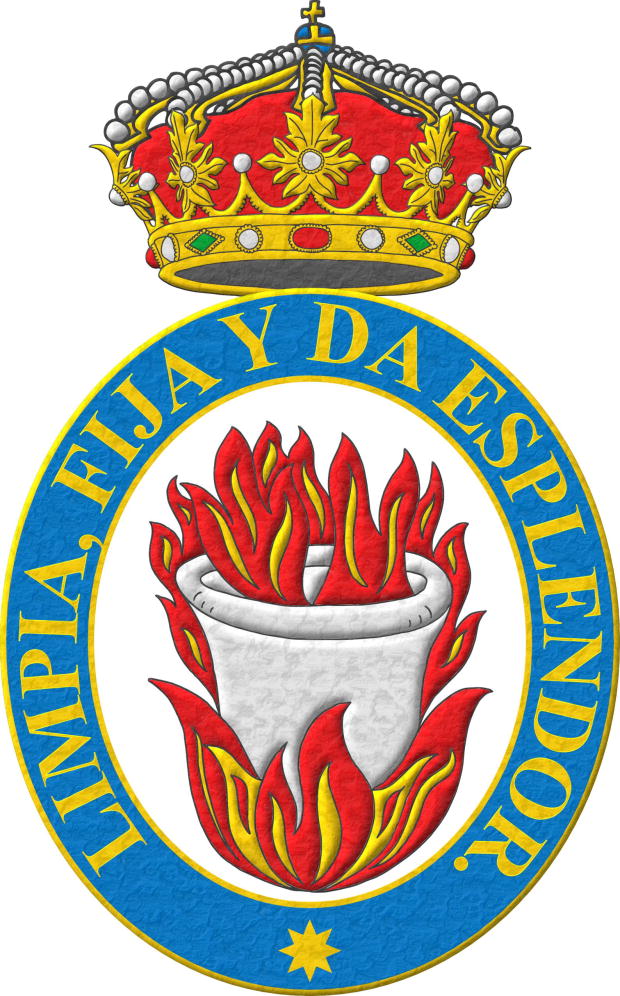
Real Academia Española, «Diccionario de la lengua española», known as DRAE, acronym for Diccionario de la Real Academia Española, 23rd edition, Espasa Calpe, Madrid, 2014.
This bibliographic reference of the DRAE is illustrated with one of my interpretations of the emblem of the Real Academia Española. Oval emblem with its crucible over a bonfire, surmounted by a closed Royal crown and its motto «Limpia, fija y da esplendor», around the emblem in letters of Or on Azure.
Bibliographical reference of century XXI.
Classification: Dictionary and Castilian language.
Author: Royal Spanish Academy.
Bibliographical reference mentioned in the following article:
External resource:

Continue with: Godfrey V, Count of Anjou.
-
Language
-
Categories of heraldry
-
Divisions of the field
- Without divisions
- Party per pale
- Party per fess
- Party per bend
- Party per bend sinister
- Tierce
- Tierce sinister
- Tierced per pale
- Tierced per fess
- Tierced per bend
- Tierced pallwise inverted
- Quarterly
- Quarterly per saltire
- Gyronny
- Party per fess, the chief per pale
- Party per pale, the sinister per fess
- Party per fess, the base per pale
- Party per pale, the dexter per fess
- Chapé
- Chaussé
- Embrassé
- Contre-embrassé
- Party per chevron
- Enté
- Enté en point
- Flanched
-
Metals
-
Colours
-
Furs
-
Other tinctures
-
Ordinaries and sub-ordinaries
-
Diminutives of the ordinaries
-
Geometric charges
-
Composite ordinaries
-
Inanimate charges from Nature
Atom, Crescent, Diamond, Emerald, Estoile, Increscent, Lightning flash, Moon, Mount, Mullet, Mullet of four points, Orbital, Plough of Ursa Major, Rainbow, Ray of the sun, River, Sea, Snowflake, Sun, Sun in splendour, Sun of May, Trimount, Water and Wave.
-
Vegetal charges from Nature
Acorn, Apple, Apple tree, Ash, Bluebonnet, Camellia, Chrysanthemum, Cinquefoil, Cornflower, Dogwood flower, Double rose, Elm, Fleur de lis, Flower, Gourd, Holm oak, Hop cone, Kapok tree, Laurel, Lily, Linden, Lotus flower, Madonna lily, Mexican cedar tree, Oak, Olive tree, Palm tree, Plantain plant, Pomegranate, Poplar leaf, Rose, Shamrock, Sunflower, Thistle, Tree, Tulip, Vine and Wheat.
-
Animal charges from Nature
Badger, Bald eagle, Barbel, Barn owl, Bear, Beaver, Beetle, Bighorn sheep, Blackbird, Boar, Brach hound, Bull, Doe, Dog, Dolphin, Dove, Eagle, Elephant, Falcon, Female figure, Fish, Flame, Fly, Fox, Frog, Goat, Goldfinch, Goose, Heron, Horse, Hummingbird, Jaguar, Lark, Leopard, Lion, Lion passant, Lion rampant guardant, Lioness, Lynx, Male figure, Martlet, Merino ram, Owl, Panther, Parrot, Peacock, Pelican, Pelican in her piety, Puffin, Quetzal, Raven, Roe deer, Rooster, Savage, Seagull, Serpent, She-wolf, Stag, Starling, Talbot, Tyger, Vulture, Warren hound and Wolf.
-
Parts of natural charges
Arm, Beak, Branch, Caboshed, Chest, Claw, Covert, Dorsal fin, Eagle claw, Ermine spot, Escallop, Feather, Foot (palmiped), Foreleg, Forepaw, Hand, Head, Heart, Hoof, Leaf, Neck, Ostrich feather, Palm frond, Paw, Roe deers' attires, Shoulder, Sprig, Stags' attires, Stem, Swallow-tail, Tail, Tail addorsed, Tail fin, Talon, Tooth, Trunk, Trunk (elephant), Two hands clasped, Two wings in vol, Udder, Wheat spike, Wing and Wrist.
-
Artificial charges
Ace of spades, Anchor, Anvil, Arch, Arm vambraced, Armillary sphere, Arrow, Axe, Bell, Bell tower, Beret, Bonfire, Book, Bookmark, Bow, Branding iron, Bridge, Broken, Buckle, Cannon, Cannon dismounted, Cannon port, Canopy roof, Carbuncle, Castle, Celtic Trinity knot, Chain, Chess rooks, Church, Clarion, Clay pot, Closed book, Club, Column, Comb, Compass rose, Conductor's baton, Cord, Covered cup, Crozier, Crucible, Cuffed, Cup, Cyclamor, Dagger, Double vajra, Drum, Ecclesiastical cap, Fanon, Federschwert, Fleam, Four crescents joined millsailwise, Galician granary, Garb, Gauntlet, Geometric solid, Grenade, Halberd, Hammer, Harp, Host, Hourglass, Key, Key ward, Knight, Knot, Lantern, Letter, Line, Loincloth, Menorah, Millrind, Millstone, Millwheel, Monstrance, Mortar, Mullet of six points pierced, Nail, Non-classic artifact, Norman ship, Number, Oar, Oil lamp, Open book, Page, Pair of scales, Parchment, Pestle, Piano, Pilgrim's staff, Plough share, Polish winged hussar, Port, Portcullis, Potent, Quill, Ribbon, Rosette of acanthus leaves, Sabre, Sackbut, Sail, Scroll, Scythe, Sheaf of tobacco, Ship, Skirt, Spear, Spear's head, Stairway, Star of David, Step, Sword, Symbol, Tetrahedron, Torch, Tower, Trident, Trumpet, Turret, Two-handed sword, Wagon-wheel, Water-bouget, Wheel, Winnowing fan and With a turret.
-
Immaterial charges
Angel, Archangel, Basilisk, Dragon, Dragon's head, Garuda, Golden fleece, Griffin, Heart enflamed, Justice, Mermaid, Our Lady of Mercy, Ouroboros, Paschal lamb, Pegasus, Phoenix, Sacred Heart of Jesus, Saint George, Sea-griffin, Trinity, Triton, Unicorn, Winged hand and Wyvern.
-
External elements
-
Heraldic creations
-
References
-
Formats
-
Keywords on this page
Watercolor, Pointed, Armed, Azure, Bibliography, House of Plantagenet, House of York, Crown, Closed royal crown, Crucible, Quarterly, De bibliotheca, Outlined in sable, Outlined in the field tincture, Within, Dictionary, Duchy of Aquitaine, Emblem, In black and white, In pale, Coat of arms, Accolé arms, Schema, Scroll, Fleur de lis, Personal, Godfrey V, Count of Anjou, Gules, Bonfire, Illuminated, Interpreted, Langued, Legal notice, Motto, Castilian language, Leonor de Aquitania, Leopard, Lion, Enflamed, Marmoreal, Metal beaten, Or, Without divisions, Rampant, Kingdom of France, Kingdom of England, Plain tincture, Three and One.

![Leonor de Aquitania y Enrique de Inglaterra [ Gules, a lion rampant Or, ] accolé with [ Gules, a lion passant, guardant Or ].](../escudo_armas/LeonorA.22.EnriqueII.jpg)
